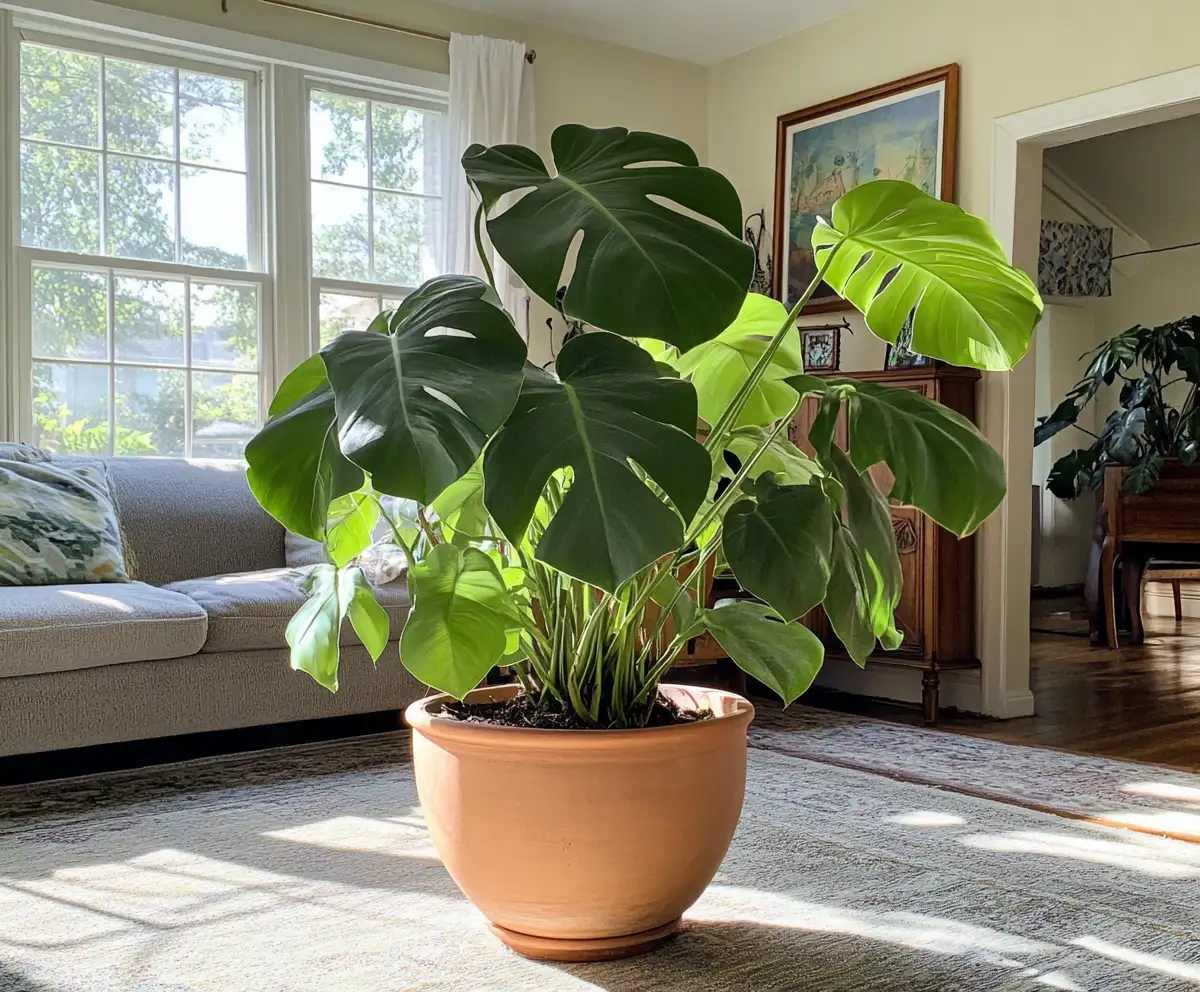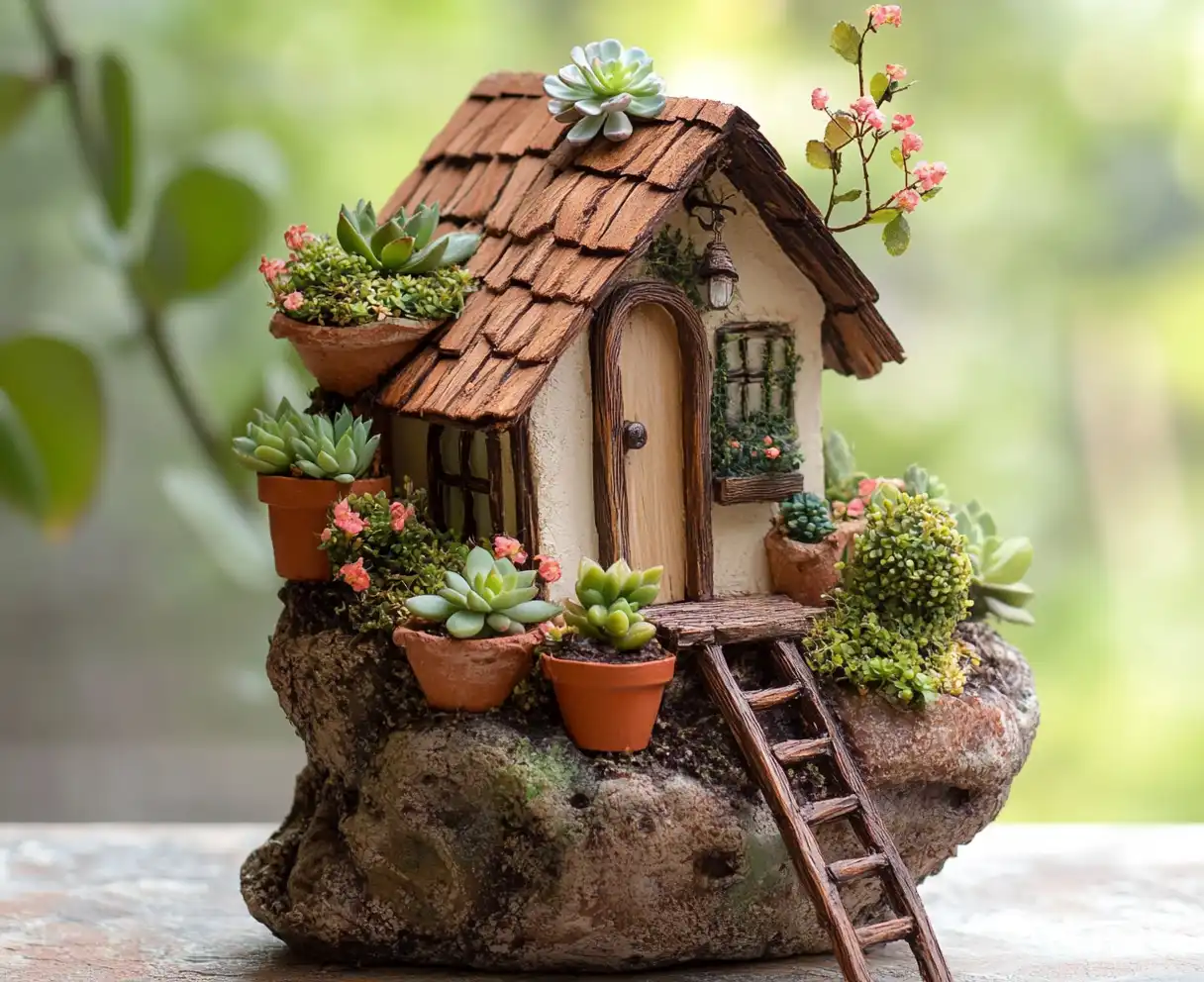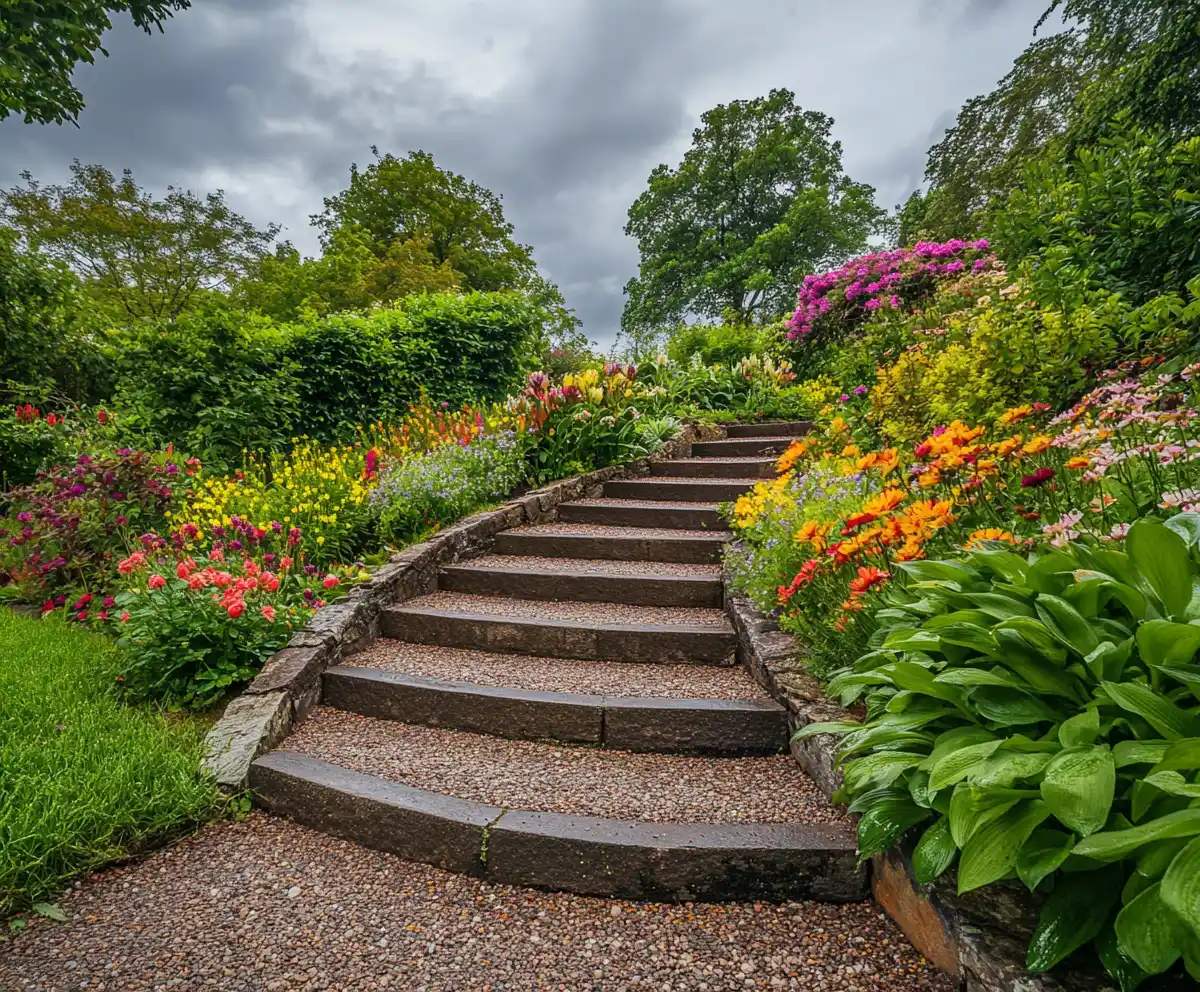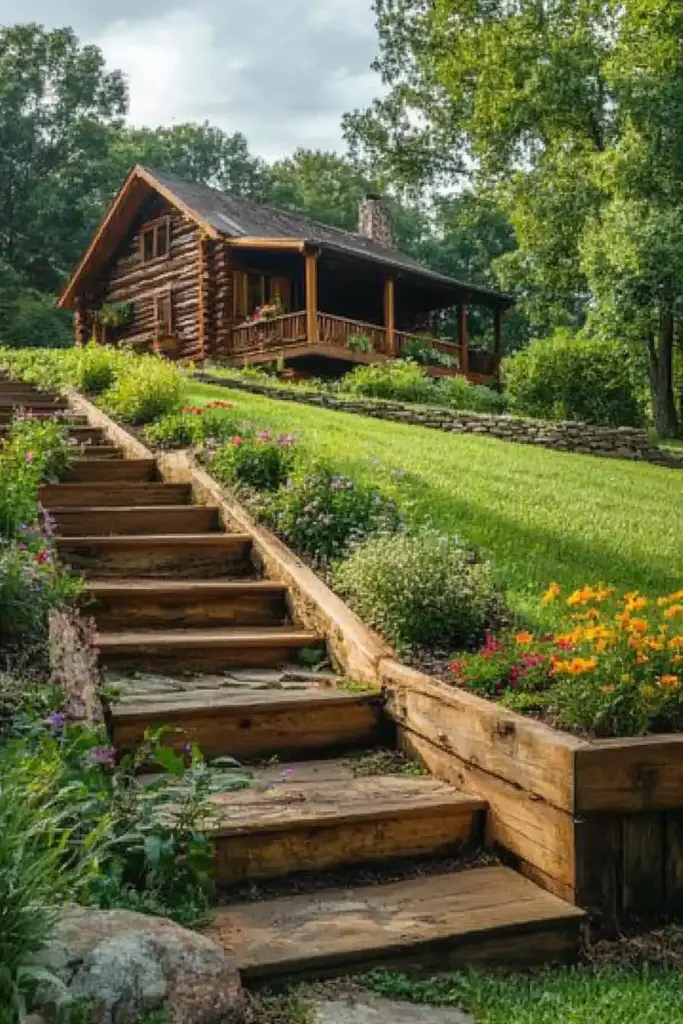Steep hill landscaping might seem overwhelming at first — especially if you’re trying to keep costs low. But a sloped yard is actually a golden opportunity to unleash your creativity and craft something both practical and stunning. Whether you’re fighting erosion, working around awkward inclines, or simply dreaming of a more vibrant outdoor space, there are smart, affordable ways to make it happen. From eco-friendly rainscaping ideas that help with drainage to budget backyard transformations that deliver serious impact, this guide walks you through 17+ innovative ideas to make the most of your hillside — all while blending function with charm.
Ready to give your sloped yard a serious makeover? Let’s dig in! 🌿
Table of Contents
1. Go for a Rustic Look with Reclaimed Wood
One of the most effective — and budget-friendly — ways to tackle steep hill landscaping is by using reclaimed wood. Whether you’re building garden steps, retaining walls, or decorative terraces, reclaimed lumber brings a rustic, earthy aesthetic that blends beautifully with natural surroundings. Plus, it’s a sustainable way to reuse materials that might otherwise end up in a landfill.
You can find reclaimed wood at salvage yards, demolition sites, or even local classified ads. Old railway ties, barn wood, or deck planks can be repurposed into sturdy structures that add both function and style. Letting the wood weather naturally adds to the charm, while a coat of eco-friendly wood preservative can extend its life in outdoor conditions.
Quick Tips:
- Use landscape fabric underneath wood features to prevent weed growth and soil erosion.
- Choose untreated hardwoods when possible to avoid chemicals leaching into your garden soil.
- Combine wood with gravel or stone edging for added stability on sloped terrain.
Rustic doesn’t mean rough — with a little care, reclaimed wood structures can be both elegant and enduring.
2. Opt for Layered Planting
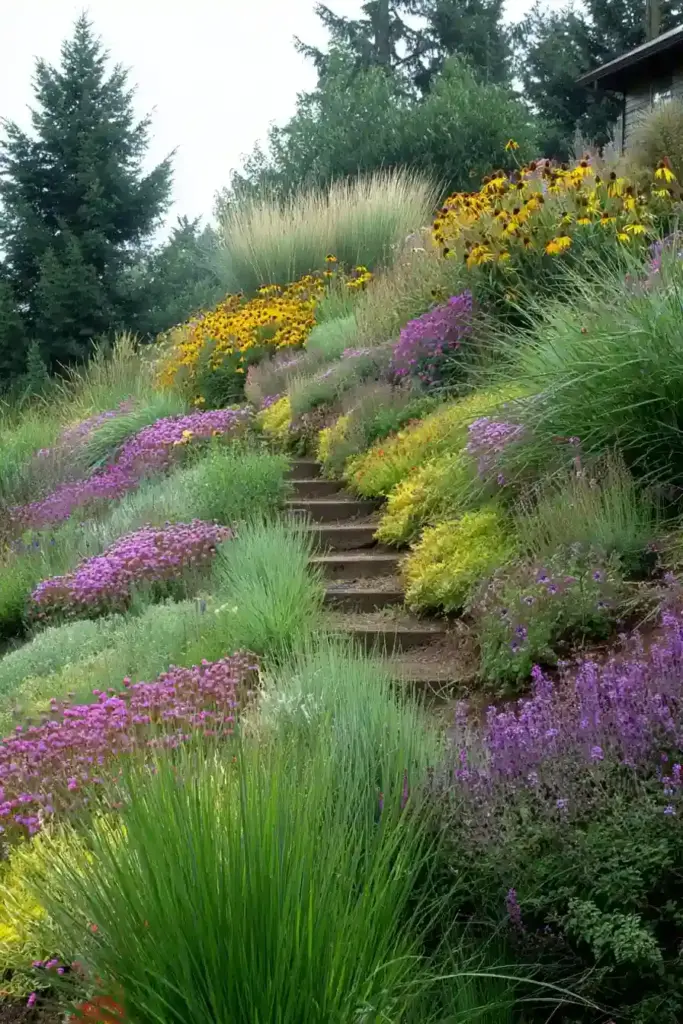
Layered planting is a clever and visually striking technique that works exceptionally well in steep hill landscaping. By arranging plants in tiers — tallest at the top and shorter varieties in front — you create depth, cohesion, and a more natural flow down the slope. This method not only enhances curb appeal but also helps with soil retention and water absorption.
Layering also allows you to play with textures, colors, and seasonal interest. Repeating plant types in drifts across the hillside can make the design feel intentional and harmonious. For example, planting tall ornamental grasses or shrubs near the top, followed by medium-sized perennials, and finally low-growing groundcovers at the base, gives the illusion of a cascading garden.
Ideal Plant Combos for Layering:
- Top layer: Butterfly bush, red hot poker, ornamental grasses
- Middle layer: Coneflowers, black-eyed Susans, lavender
- Bottom layer: Creeping thyme, sedum, moss phlox
Bonus Tips:
- Use drip irrigation for each layer to ensure even watering on a slope.
- Add mulch between layers to help retain moisture and control erosion.
- Choose plants with staggered bloom times for year-round interest.
With thoughtful planning, layered planting transforms a steep hill from an eyesore into a breathtaking garden vista.
3. Build a Simple Fire Pit
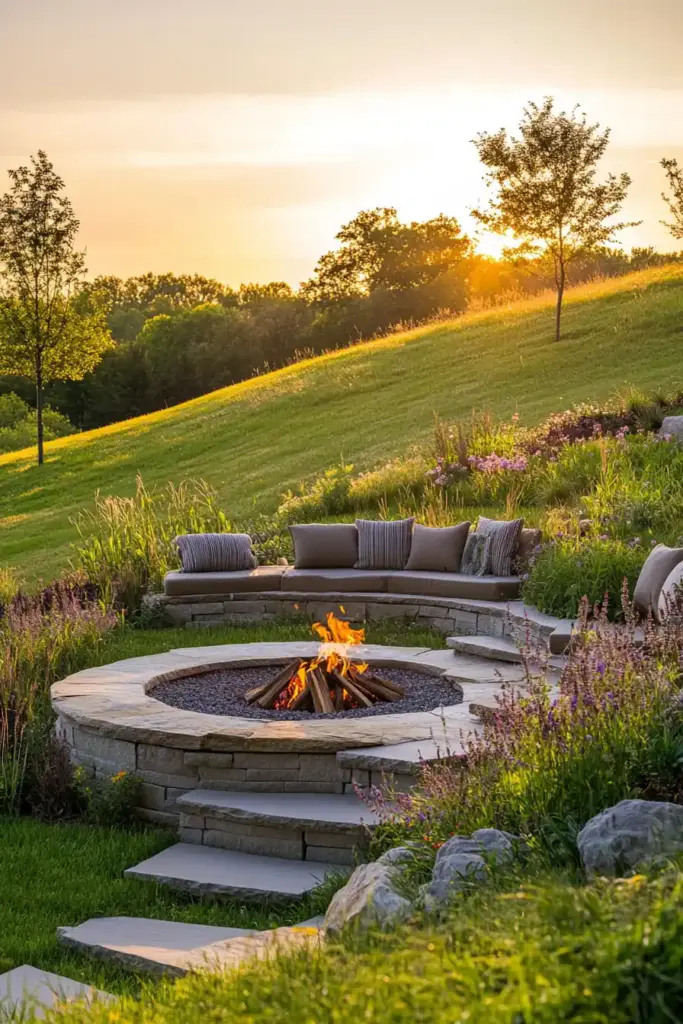
Adding a fire pit is a fantastic way to bring warmth and functionality to your steep hill landscaping design. Whether it’s a quiet night under the stars or a weekend gathering with friends, a fire pit transforms your outdoor space into a cozy retreat — and you don’t need to spend a fortune to make it happen.
The key is to keep it simple. Choose a relatively flat terrace or carve out a level nook in the slope, then line the area with gravel or pavers for safety and drainage. Use inexpensive materials like fire-rated bricks, concrete blocks, or a metal ring insert to form the base. Surround the pit with repurposed seating such as log stumps or weather-resistant benches.
Fire Pit Tips for Sloped Yards:
- Install a gravel base to prevent water pooling and to improve fire safety.
- Keep seating low and stable — concrete blocks or wide pavers work great on uneven ground.
- Add solar or string lights to enhance evening ambiance.
A well-placed fire pit not only makes your hillside inviting, it also gives you a reason to enjoy it all year long.
4. Incorporate Vertical Elements
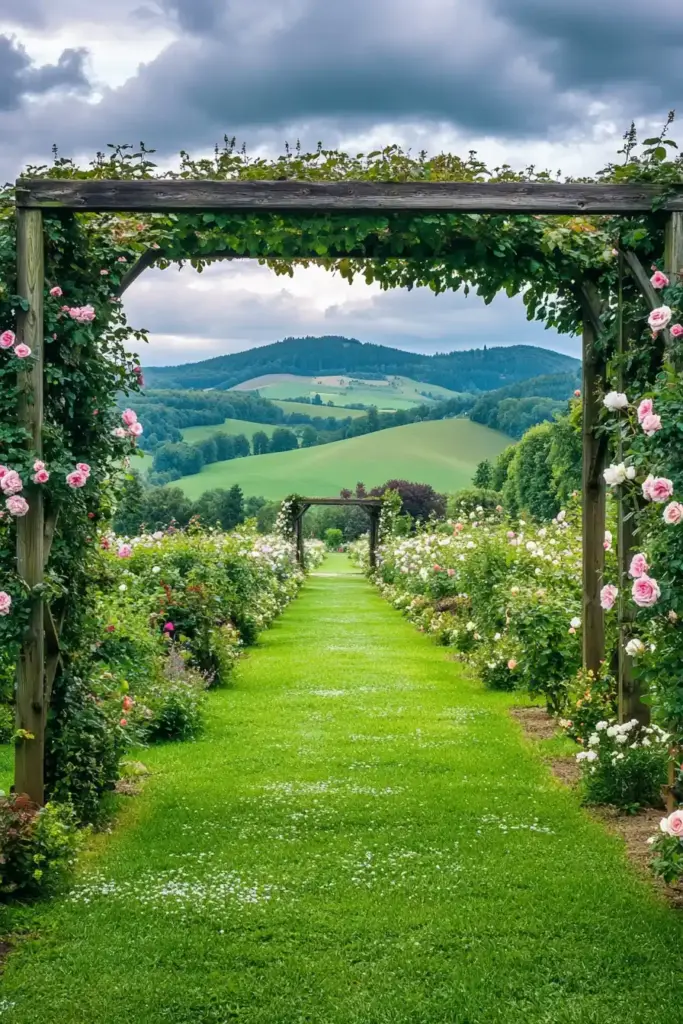
Vertical structures are game-changers in steep hill landscaping, offering height, structure, and an artistic flair to otherwise bare slopes. They draw the eye upward, create focal points, and make the most of vertical space — all while using minimal ground area.
Trellises, arbors, and garden arches are ideal for supporting climbing plants like clematis, jasmine, or even vegetables like beans and cucumbers. On steeper slopes, a row of vertical features can serve as living walls or soft dividers between terraced levels. You can also use these elements to guide pathways or create cozy, semi-private sitting areas within your hillside garden.
Creative Vertical Ideas:
- Wooden trellises for flowering vines like honeysuckle or morning glory
- Metal garden arches framing entrances to terrace landings
- Wall-mounted planters for herbs and succulents on retaining walls
Smart Tips:
- Anchor vertical elements securely, especially on uneven ground.
- Use symmetry or repetition to create a cohesive look across the hillside.
- Combine vertical features with low plantings for balance.
Vertical features are the secret to making steep slopes feel layered, lush, and thoughtfully designed — even on a budget.
5. Plant a Variety of Colorful Greenery
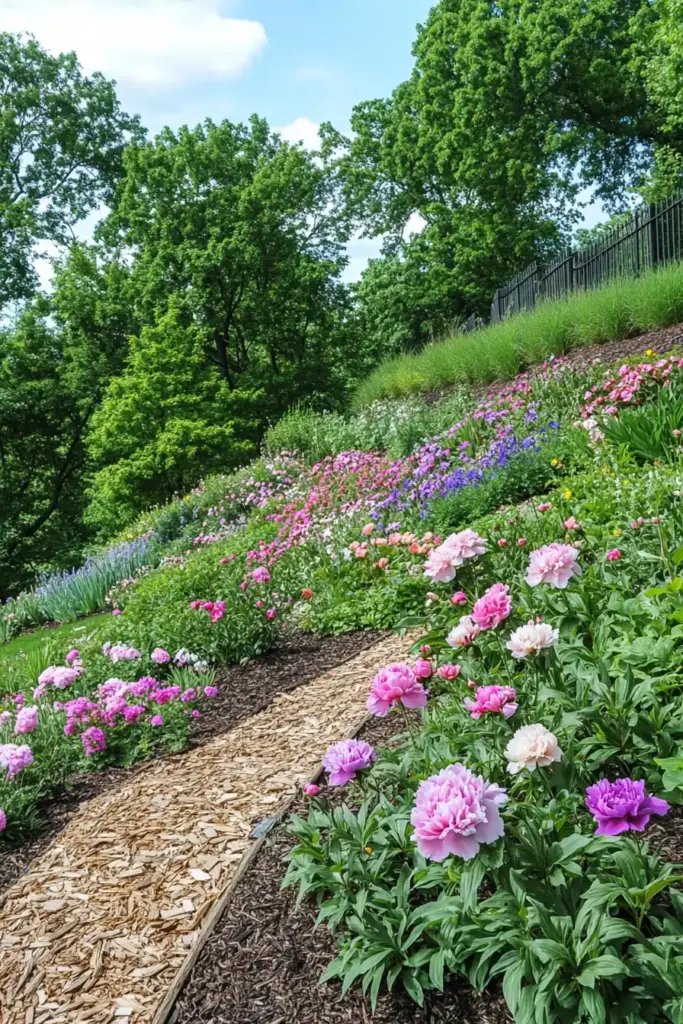
Bringing in a variety of colorful greenery can instantly brighten and soften any steep hill landscaping project. Beyond aesthetics, a mix of perennials, shrubs, and groundcovers adds biodiversity, supports pollinators, and helps stabilize the soil.
When choosing plants for a slope, focus on low-maintenance, drought-tolerant species that can thrive in well-draining soil. Think about color layering — not just in blooms, but also in foliage. Greens, purples, silvers, and reds can add depth even when flowers aren’t in bloom. The key is to pick plants with staggered blooming seasons and varied textures for interest year-round.
Colorful Plant Picks for Slopes:
- Perennials: Coreopsis, salvia, daylilies
- Shrubs: Spirea, dwarf butterfly bush, hydrangea
- Groundcovers: Creeping thyme, vinca, sedum
Helpful Hints:
- Group plants in odd-numbered clusters for a natural look.
- Mix in evergreens to maintain structure during the off-season.
- Add a few native wildflowers to support local ecosystems.
A colorful slope isn’t just beautiful — it’s practical, too. It boosts curb appeal while anchoring your hillside with nature’s own design tools.
6. Use Mulch for Moisture and Weed Control
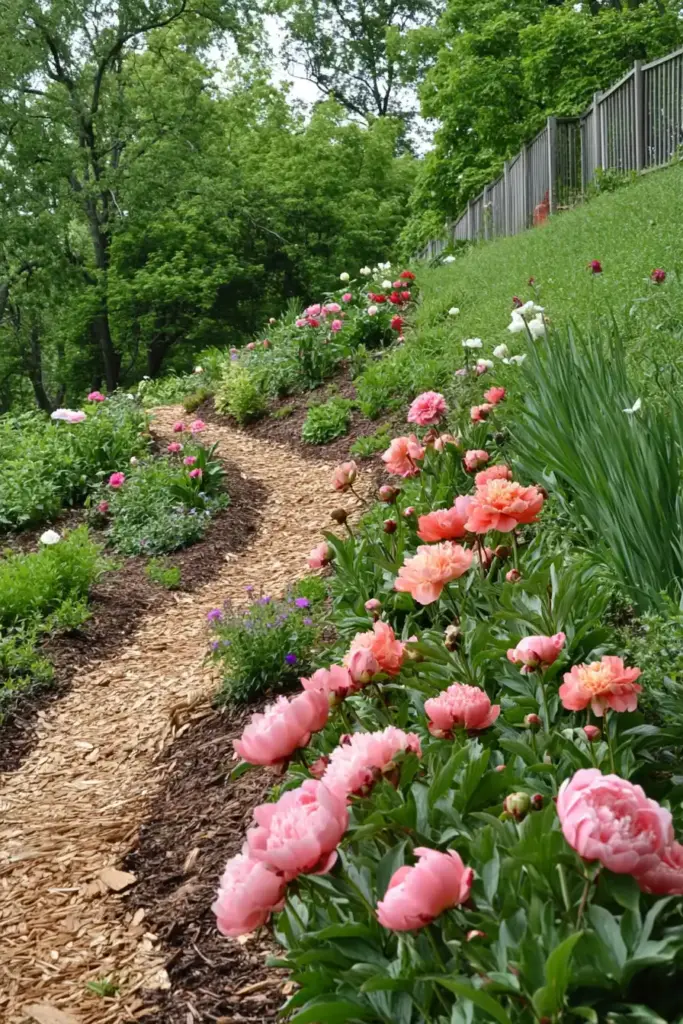
One of the most budget-friendly and effective tools in steep hill landscaping is good old-fashioned mulch. Whether you’re planting a full garden or just aiming to stabilize the slope, mulch helps retain moisture, suppress weeds, and protect your soil from erosion.
On a hillside, organic mulches like shredded bark, pine needles, or composted leaves are ideal — they’re natural, easy to apply, and break down to nourish the soil over time. For added durability, especially on steeper grades, consider pairing mulch with landscape fabric underneath to prevent washout during heavy rains.
Best Mulch Choices for Slopes:
- Shredded bark: Clings well to slopes and adds a natural look
- Pine straw: Lightweight but forms a dense mat over time
- Gravel or stone mulch: Great for dry or xeriscape-style slopes
Smart Application Tips:
- Apply 2–4 inches thick to effectively retain moisture and prevent weeds
- Use mulch edging (logs, stones, or flexible rubber) to keep it from sliding
- Reapply as needed, especially after heavy storms
Mulch is a silent hero in steep hill landscaping — invisible to some, but essential for a thriving, low-maintenance slope garden.
7. Incorporate Water Features
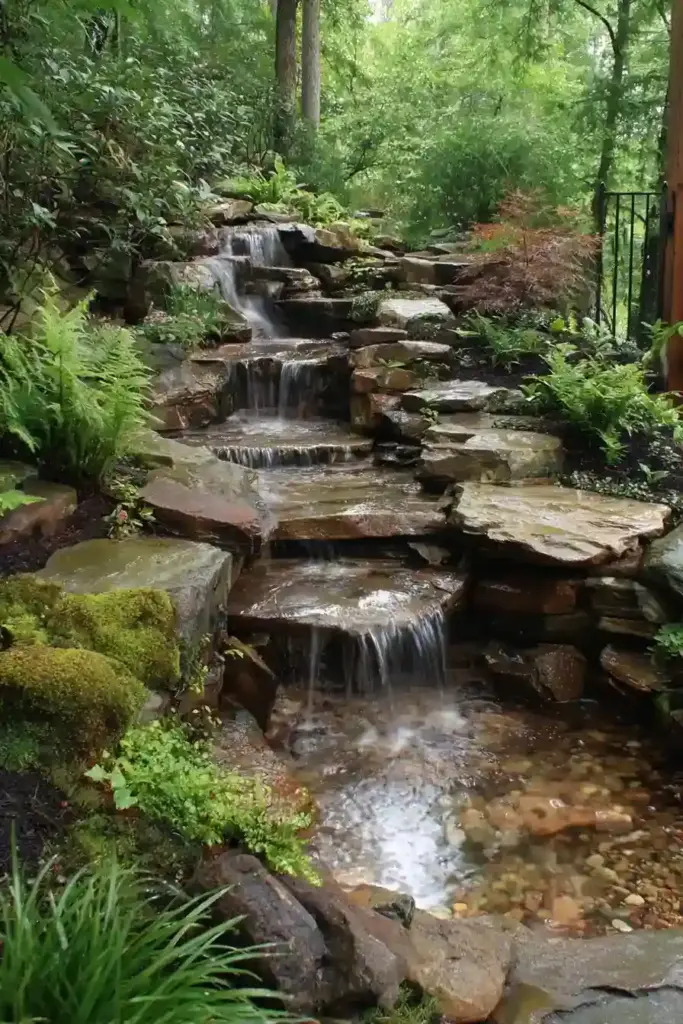
If you’re looking to add a calming, high-impact element to your steep hill landscaping, a water feature is a beautiful choice. The natural elevation makes slopes ideal for cascading water designs like small waterfalls, streams, or tiered fountains — and they don’t have to be complicated or expensive.
Even a simple solar-powered fountain or a recirculating waterfall can become a stunning centerpiece on your hillside. Besides adding tranquility and a soothing soundtrack to your yard, water features also attract birds and beneficial insects, enhancing the ecosystem.
Budget-Friendly Water Feature Ideas:
- DIY waterfall kit with a hidden basin and small pump
- Solar fountain bowls for a no-wiring-required setup
- Rock-lined stream beds to direct rainwater attractively
Slope-Smart Tips:
- Use the natural incline to your advantage — gravity helps water flow
- Line the feature with stones or plants to blend it into the landscape
- Install a drainage system or gravel base to manage runoff
Water features bring life and movement to static slopes, creating a sensory-rich experience that feels like a peaceful retreat right at home.
8. Explore Rock Gardens
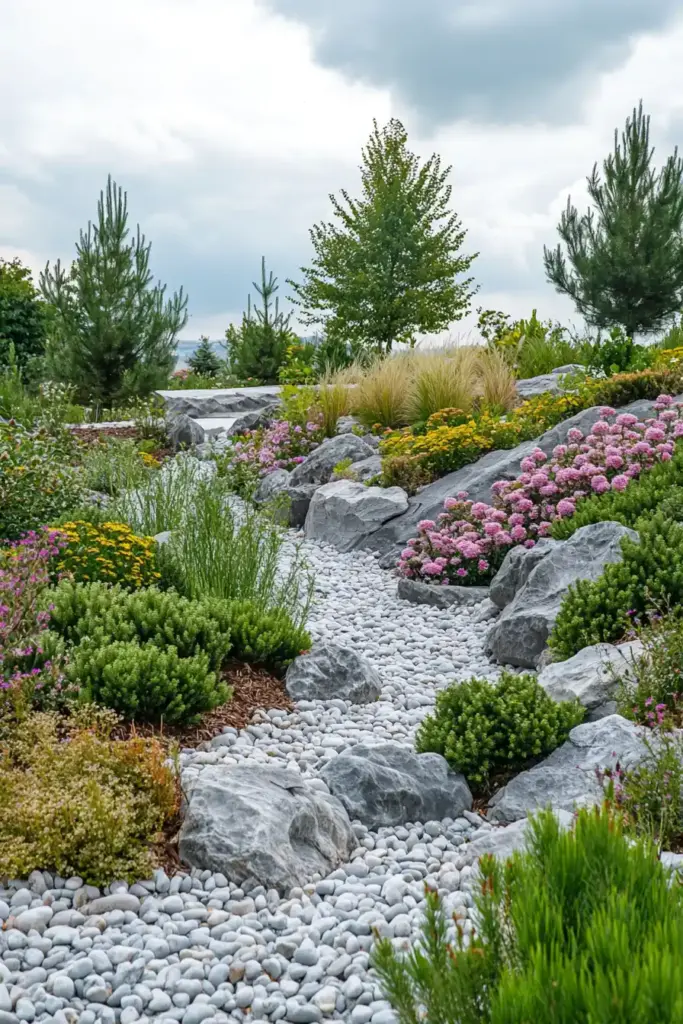
Rock gardens are a natural fit for steep hill landscaping, offering both beauty and low maintenance. By combining stones, gravel, and drought-tolerant plants, you can create a rugged, artistic landscape that thrives in sloped conditions and requires little upkeep.
The key to a great rock garden is contrast and texture. Use a mix of large boulders, medium-sized stones, and pea gravel to create depth and movement across your slope. Nestle in plants like succulents, alpine flowers, or ornamental grasses that love well-draining soil and sunny exposure. Rock gardens also naturally help with erosion control and water management.
Ideal Rock Garden Plants:
- Sedum (stonecrop)
- Sempervivum (hens and chicks)
- Lavender or creeping phlox
Rock Garden Design Tips:
- Position large rocks first as anchor points, then fill in with smaller stones
- Use native or locally sourced stones to blend with the environment
- Add low-voltage lighting to highlight textures at night
Rock gardens celebrate the raw beauty of your hillside, offering an elegant and practical way to embrace your landscape’s natural slope.
9. Use Native Plants for Low Maintenance
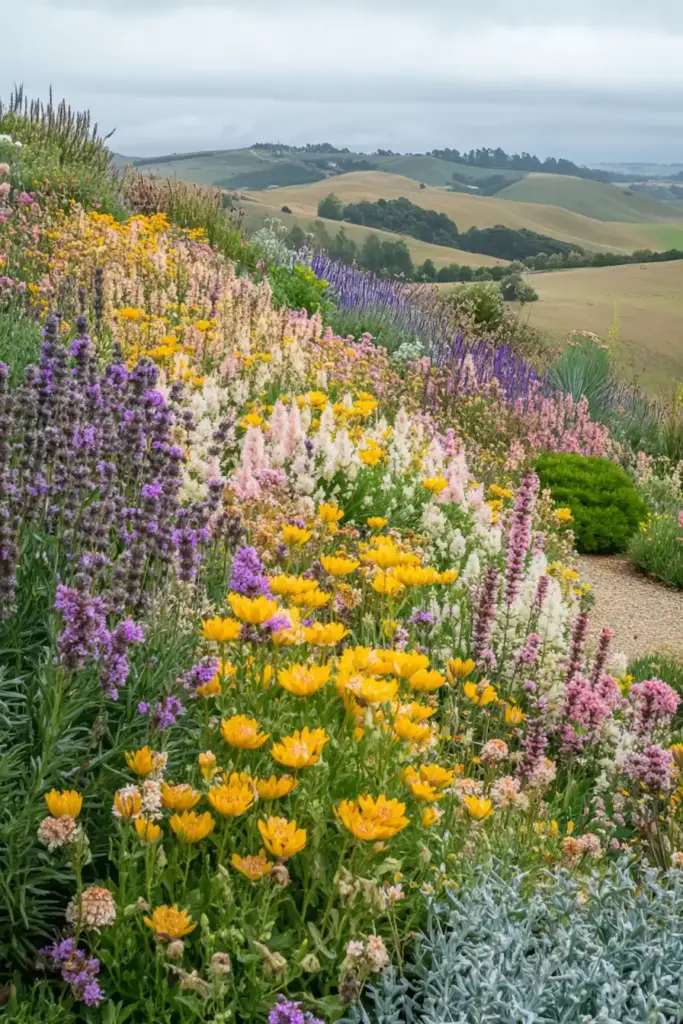
When it comes to sustainable and low-effort steep hill landscaping, native plants are your best allies. These plants are naturally adapted to your local climate, soil conditions, and rainfall — which means they require less water, less fertilizer, and virtually no pampering once established.
Native plants also play a vital role in supporting local wildlife, attracting pollinators like bees, butterflies, and birds. For sloped yards, they help stabilize the soil with deep root systems and often thrive where more delicate species would struggle.
Why Go Native?
- Low maintenance: Less watering, pruning, and fertilizing
- Erosion control: Deep roots anchor soil effectively
- Eco-friendly: Supports local biodiversity and reduces resource use
Native Plant Suggestions (varies by region):
- Purple coneflower (Echinacea)
- Yarrow (Achillea)
- Little bluestem (Schizachyrium scoparium)
- Wild columbine (Aquilegia canadensis)
Not only do native plants simplify your landscaping routine, they also let your hillside thrive in harmony with nature — affordably and beautifully.
10. Design Functional Spaces

A steep slope doesn’t mean you have to sacrifice comfort — in fact, steep hill landscaping can include some of the most charming and creative outdoor living areas. With a little planning, you can carve out cozy, functional spaces like reading nooks, small patios, or even open-air dining areas that make the most of your hillside.
Start by identifying flatter zones or consider building small terraces using retaining walls or logs. These flat pockets can then be styled with weather-resistant furniture, outdoor rugs, and solar lights to create inviting retreats. Whether it’s a stone bench under a tree or a tucked-away bistro set, functional spaces bring new life to your yard.
Functional Ideas for Sloped Yards:
- Terraced seating zones with gravel or flagstone bases
- Hidden hammock corners surrounded by shrubs or vines
- Mini patio pads for morning coffee or sunset watching
Design Tips:
- Place seating where the view is best to capitalize on elevation
- Add path lighting for safe access during evenings
- Incorporate shade elements, like pergolas or umbrellas, if sun exposure is intense
Don’t just landscape your hillside — live in it. Thoughtfully designed spaces turn a slope into a series of experiences, not just a view.
11. Create Pathways and Steps
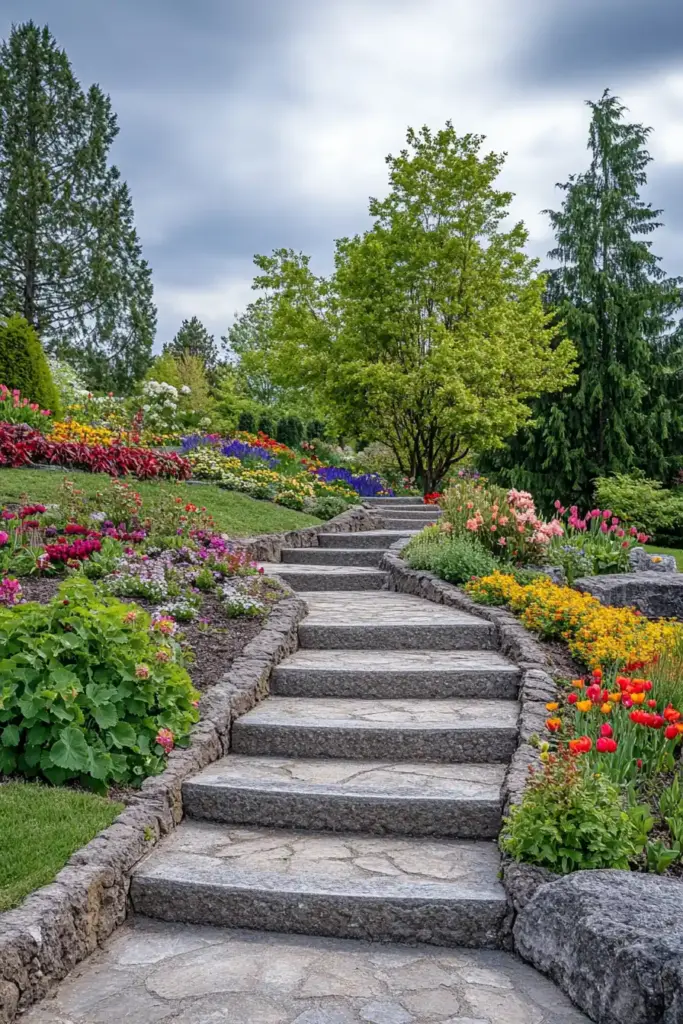
Accessibility is key in any landscape, and in steep hill landscaping, creating safe, attractive pathways and steps is both a practical and aesthetic necessity. Well-placed paths help guide movement across your slope, prevent erosion, and define the flow of your garden design.
You don’t need fancy materials — gravel, flagstone, wooden sleepers, or even recycled bricks can all be used to create sturdy, visually appealing paths. For steps, consider building with materials that complement your surroundings, such as timber, stone, or concrete pavers. If possible, contour your paths with gentle curves instead of straight lines to better follow the hill’s natural grade.
Path & Step Materials:
- Crushed gravel for drainage and rustic charm
- Natural stone slabs for elegance and durability
- Treated wood or railroad ties for a rustic or cottage-style look
Tips for Success:
- Use landscape edging to keep materials in place and reduce maintenance
- Incorporate handrails or low walls for safety on steeper inclines
- Install solar path lights for visibility and ambiance after dark
A beautiful pathway does more than connect spaces — it invites exploration and ensures your hillside landscape is as usable as it is lovely.
12. Embrace Terracing with Natural Materials
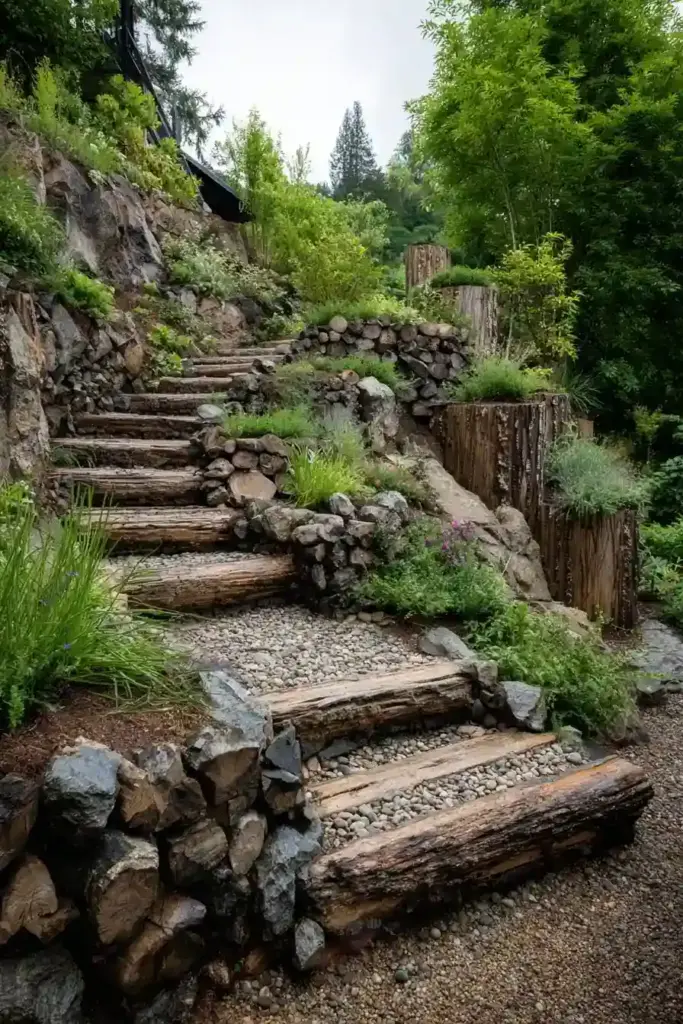
When you’re dealing with a steep slope, terracing is one of the most effective techniques in steep hill landscaping. By creating flat, usable levels, you not only control erosion but also gain functional planting or sitting areas that feel intentional and organized.
The best part? You don’t need to spend a fortune on concrete or engineered blocks. Instead, use natural materials like logs, large stones, reclaimed bricks, or even compacted earth. These options are budget-friendly, visually warm, and blend beautifully into organic garden designs.
Smart Materials for Terracing:
- Stacked logs or timber beams for a rustic, woodland look
- Dry-stacked stones for a natural, classic garden vibe
- Reclaimed bricks or pavers for old-world charm and character
Terracing Tips:
- Build retaining walls with drainage in mind — always leave room for water runoff
- Layer terraces with plants, seating, or decor to maximize usability
- Use native grasses or groundcovers on terrace edges to prevent washout
Terracing isn’t just functional — it’s transformative. With each level, your hillside becomes a series of garden rooms waiting to be explored.
13. Utilize Old Tires for Creative Planters
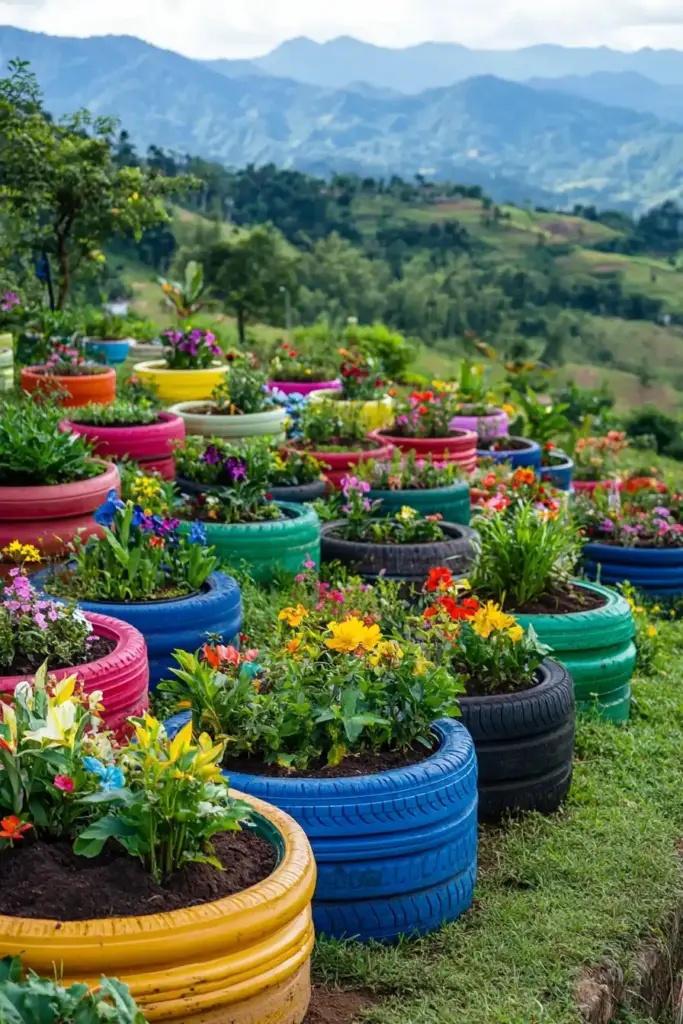
Looking for a fun, eco-friendly twist on steep hill landscaping? Try repurposing old tires as colorful, durable planters. This budget-conscious idea not only recycles waste but also adds a splash of creativity to your slope — especially in kids’ gardens or playful outdoor spaces.
Tires are surprisingly versatile: stack them for depth, cut them for shape, or paint them bold colors for added personality. They’re great for growing herbs, small flowers, or even shallow-rooted veggies, and their weight helps them stay put on inclined surfaces. Plus, they naturally retain warmth, encouraging healthy root growth.
Creative Tire Planter Ideas:
- Stacked herb spirals on a slope using 2–3 tires
- Hanging tire planters mounted to fences or retaining walls
- Painted tire flower beds arranged in clusters by color
Helpful Tips:
- Drill drainage holes at the bottom before planting
- Use non-toxic outdoor paint if you plan to paint the tires
- Fill with quality potting mix and top with mulch to retain moisture
Who knew upcycling could look this good? Tire planters are proof that functional and fun can go hand-in-hand — especially on a hillside.
14. Add a Pop of Color with Flowering Shrubs
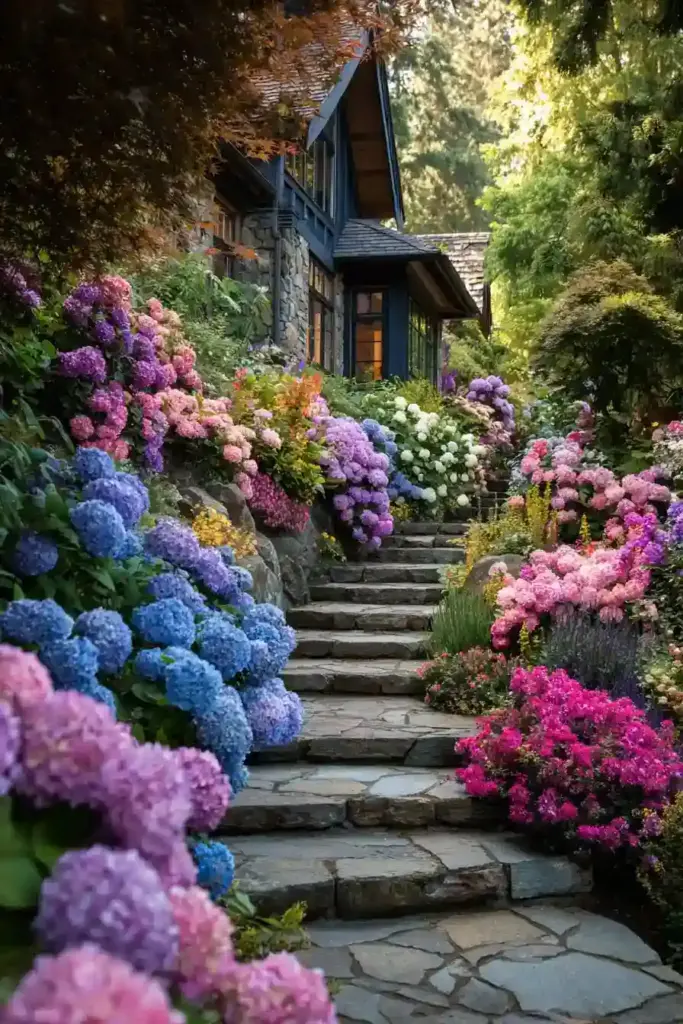
If you want long-lasting color and structure in your steep hill landscaping, flowering shrubs are a must-have. These hardy, often low-maintenance plants provide year-round visual interest, act as living anchors for the soil, and attract birds and pollinators to your garden.
On a slope, flowering shrubs can also serve as natural erosion control, thanks to their dense root systems. They’re perfect for filling awkward corners or framing terraces and pathways. Choose a mix of early and late bloomers to ensure vibrant color through spring, summer, and fall.
Favorite Flowering Shrubs for Slopes:
- Hydrangea – large blooms, partial shade tolerant
- Azalea – early-season color, great for woodland slopes
- Butterfly bush – drought-tolerant and pollinator-friendly
- Potentilla – hardy, compact, and blooms all summer
Planting Tips:
- Space shrubs according to their mature width for proper airflow and root development
- Apply mulch around the base to retain moisture and reduce weeds
- Consider grouping 3–5 of the same variety for a bolder visual impact
Flowering shrubs are the workhorses of hillside gardens — colorful, reliable, and perfect for turning a steep slope into a blooming masterpiece.
15. Create a Zen Garden Space
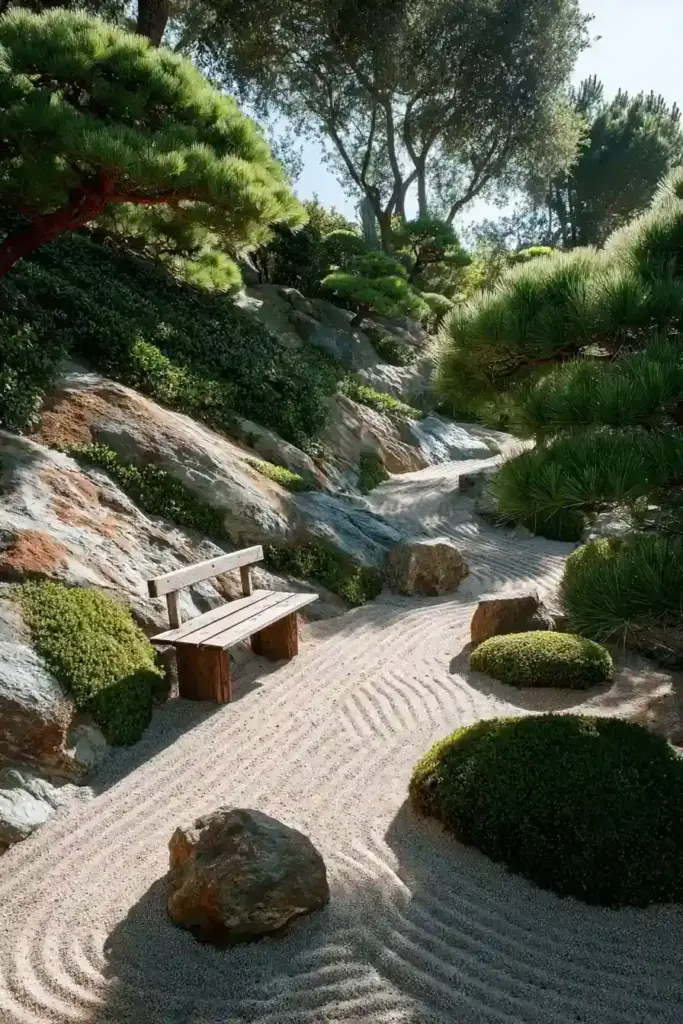
Incorporating a Zen garden into your steep hill landscaping design introduces a sense of tranquility and balance to an otherwise dynamic terrain. Zen gardens — also known as Japanese rock gardens — use minimalist elements like raked sand, stones, and carefully placed plants to evoke calm and mindfulness.
These gardens are ideal for small, terraced landings or tucked-away corners of a slope. Even a compact space can become a serene sanctuary with a few simple materials and thoughtful layout. Add a small bench or stone seat for meditation, and you’ll have a peaceful escape just steps from your back door.
Elements of a Zen Garden:
- Raked sand or gravel to represent water or flow
- Carefully arranged rocks for structure and symbolism
- Minimal, low-maintenance plants like moss, dwarf pines, or ferns
Design Tips:
- Choose a shaded or semi-shaded spot to enhance the meditative atmosphere
- Use neutral colors and natural textures to keep the space grounded
- Incorporate bamboo screens or a wooden fence for privacy if needed
A Zen garden adds more than beauty — it creates space to slow down, breathe deeply, and reconnect with nature on your hillside.
16. Incorporate Edible Plants
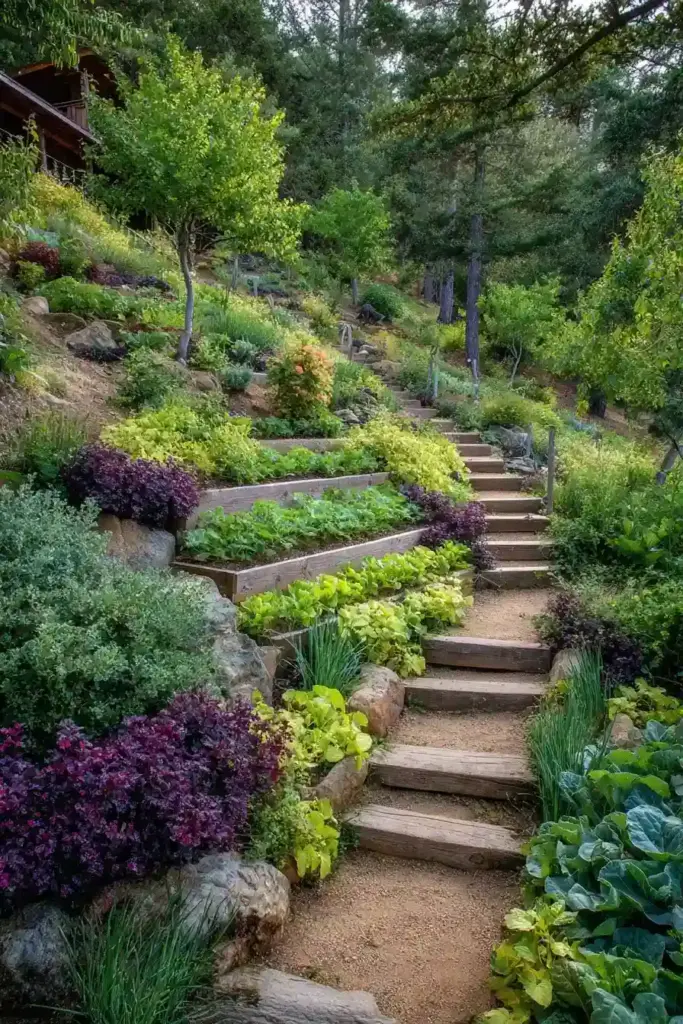
Why not make your steep hill landscaping not only beautiful but also bountiful? Planting edible plants like herbs, berries, or compact vegetables is a smart way to blend form and function — especially if you’re working with limited space. Slopes offer great drainage and sun exposure, which many edibles love.
Herbs like rosemary, thyme, and oregano thrive in well-drained soil and double as fragrant groundcovers. You can also tuck in berry bushes like blueberries or raspberries along terraced edges for a delicious, low-maintenance harvest. The best part? You’ll have fresh flavors growing just steps from your kitchen.
Top Edible Plants for Slopes:
- Herbs: Sage, thyme, oregano, lavender
- Berry bushes: Blueberries, blackberries, strawberries
- Dwarf fruit trees (on flat terraces): Apples, figs, or citrus varieties
Planting Tips:
- Group edibles by sun and water needs for easy care
- Add mulch to conserve moisture and reduce weeding
- Use raised beds or planters on steeper inclines for easier harvesting
Edible plants add a whole new layer of purpose to your hillside garden — turning it into a source of both nourishment and natural beauty.
17. Install a Simple Irrigation System
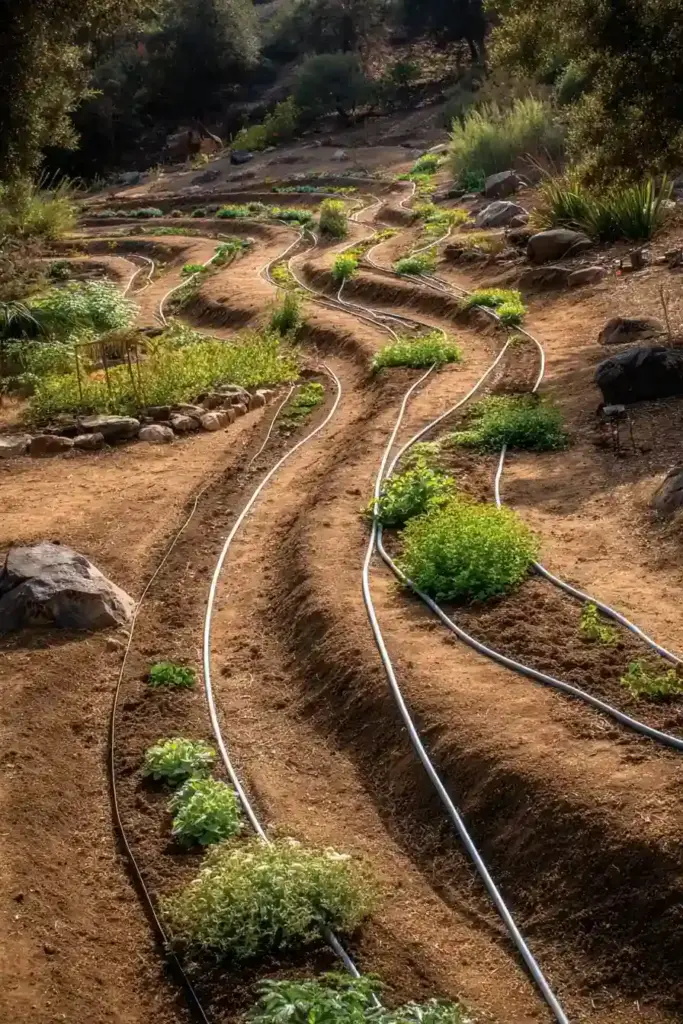
One of the smartest investments you can make in your steep hill landscaping is a simple irrigation system. Sloped gardens often suffer from uneven watering — with upper sections drying out and lower ones becoming oversaturated. A drip irrigation setup solves this by delivering water slowly and directly to plant roots, minimizing waste and runoff.
Drip systems are surprisingly affordable and easy to install. You can customize them to suit your layout, connecting emitters to each plant or row. Add a programmable timer, and you’ll automate your watering routine — perfect for busy schedules or hot summer days.
Irrigation Essentials:
- Drip irrigation kits with customizable tubing and emitters
- Soaker hoses for groundcovers or densely planted areas
- Automatic timers to regulate watering schedules
Setup Tips:
- Always start from the top of the slope so gravity aids distribution
- Test flow rates to ensure even coverage on all levels
- Bury or cover tubing with mulch or stone for a cleaner look and longer lifespan
With a good irrigation system in place, your steep hillside becomes not only easier to manage — it becomes self-sustaining.
Conclusion
Steep hill landscaping doesn’t have to be a source of stress — in fact, with a little imagination and a budget-conscious approach, your slope could become the standout feature of your entire yard. Whether you’re adding colorful flower beds, crafting cozy terraced spaces, or exploring natural landscaping materials, there are countless ways to make your hillside both functional and beautiful. With the right ideas and a bit of DIY spirit, your steep yard can blossom into a lush, welcoming retreat you’ll love for years to come.
🌱 Frequently Asked Questions (FAQ)
1. What is the best way to landscape a steep hill on a budget?
The most cost-effective way to tackle steep hill landscaping is by using reclaimed materials like wood or stone, planting native species, and incorporating DIY solutions like tire planters or gravel paths. Focus on erosion control and functionality before adding decorative elements.
2. How do I prevent erosion on a sloped yard?
To prevent erosion, use techniques such as terracing, mulching, planting groundcovers, and installing retaining walls. Native plants and deep-rooted shrubs are especially effective in stabilizing soil on hillsides.
3. Can I plant vegetables on a steep hill?
Yes! You can grow herbs, berries, and compact vegetables by creating terraced beds or using raised planters. Choose drought-tolerant, shallow-rooted edibles, and ensure consistent watering with a drip irrigation system.
4. Do I need professional help to landscape a steep slope?
Not necessarily. Many steep hill landscaping projects can be done DIY with the right planning. However, for major grading, drainage issues, or retaining wall installation, professional guidance is recommended for safety and longevity.
5. What are the best plants for steep slopes?
Ideal plants for hillsides include creeping thyme, sedum, lavender, ornamental grasses, hydrangeas, and native wildflowers. Look for plants with deep or spreading roots that hold soil in place and require minimal upkeep.
6. How do I water a hillside garden efficiently?
A drip irrigation system is the most efficient way to water a hillside. It delivers water directly to the plant roots, minimizes runoff, and can be automated with a timer for convenience and consistency.
🌿 Love gardening inspiration? Follow me on Pinterest for bold plant ideas, tips, and seasonal color!
More Posts



